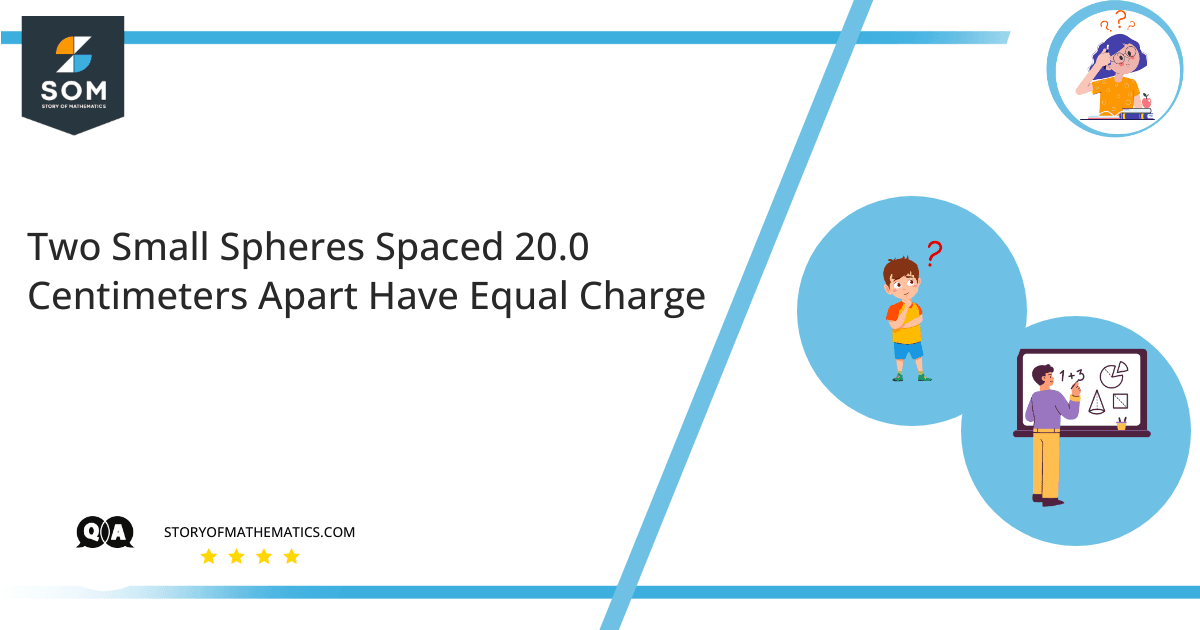
If the spheres repel each other with a repulsive force having a magnitude of 3.33X10^(-21) N, calculate the excess electrons that each sphere carries.
This question aims to find the number of excess electrons present on a set of bodies that causes them to repel each other.
The basic concept behind this article is the Electrostatic Force and Coulomb’s Law for Charged Bodies.
The Electrostatic Force is defined as one of the fundamental forces in nature that exist between two bodies that carry an electric charge and are separated by a finite distance. This force can be repulsive or attractive and varies as the distance between the body changes.
If the charge on bodies is opposite to each other, the electrostatic force is attractive. If the charges are the same, the electrostatic force is repulsive.
Its standard unit of measurement is Newton $N$.
The Electrostatic Force is calculated with the help of Coulomb’s Law, which states that the electrostatic force between two charged bodies is directly proportional to the product of electric charges on the bodies and inversely proportional to the square of the finite distance between the bodies.
\[F=k\ \frac{q_1q_2}{r^2}\]
Where:
$F=$ Electrostatic Force
$q_1=$ Charge of First Body
$q_2=$ Charge of Second Body
$r=$ Distance between two bodies
$k=$ Coulomb’s Constant $=\ 9.0\times{10}^9\ \dfrac{N.m^2}{C^2}$
Expert Answer
Given that:
Distance between Sphere 1 and 2 $=r=20\ cm=20\times{10}^{-2}\ m$
Electrostatic Force $F=3.33\times{10}^{-21}\ N$
The charge on both spheres is the same, hence:
\[q_1=q_2=Q\]
First, we will find the magnitude of electric charge on both spheres by using Coulomb’s Law:
\[F\ =\ k\ \frac{q_1q_2}{r^2}\]
Since $q_1\ =\ q_2\ =\ Q$ , so:
\[F\ =\ k\ \frac{Q^2}{r^2}\]
By rearranging the equation:
\[Q=\ \sqrt{\frac{F\times r^2}{k}}\]
Substituting the given values in the above equation:
\[Q\ =\ \sqrt{\frac{(3.33\ \times\ {10}^{-21}\ N)\times{(20\ \times{10}^{-2}\ m)}^2}{\left(9.0\ \times\ {10}^9\ \dfrac{N.m^2}{C^2}\right)}}\]
\[Q\ =\ 1.22\ \times\ {10}^{-16}\ C\]
This is the charge on both the spheres.
Now, we will calculate the excess electron carried by spheres by using the formula for the electric charge as follows:
\[Q\ =\ n\times e\]
Where:
$Q\ =$ Electric charge on the body
$n\ =$ Number of electrons
$e\ =$ Electric Charge on an electron $=\ 1.602\ \times\ {10}^{-19}\ C$
So, by using the above formula:
\[n\ =\ \frac{Q}{e}\]
\[n\ =\ \frac{1.22\ \times\ {10}^{-16}\ C}{1.602\ \times\ {10}^{-19}\ C}\]
\[n\ =\ 0.7615\ \times\ {10}^3\]
\[n\ =\ 761.5\]
Numerical Result
The excess electrons that each sphere carries to repel each other are $761.5$ Electrons.
Example
Two bodies having an equal and same charge of $1.75\ \times\ {10}^{-16}\ C$ in space are repelling each other. If the bodies are separated by a distance of $60cm$, calculate the magnitude of the repulsive force acting between them.
Solution
Given that:
Distance between two bodies $=\ r\ =\ 60\ cm\ =\ 60\ \times{10}^{-2}\ m$
The charge on both bodies is the same. $q_1\ =\ q_2\ =\ 1.75\ \times\ {10}^{-16}\ C$
As per Coulomb’s Law, the repulsive Electrostatic Force is:
\[F\ =\ k\ \frac{q_1q_2}{r^2}\]
\[F\ =\ (9.0\ \times\ {10}^9\ \frac{N.m^2}{C^2})\ \frac{{(1.75\ \times\ {10}^{-16}\ C)}^2}{{(60\ \times{10}^{-2}\ m)}^2}\]
\[F\ =\ 7.656\times\ {10}^{-16}\ N\]
